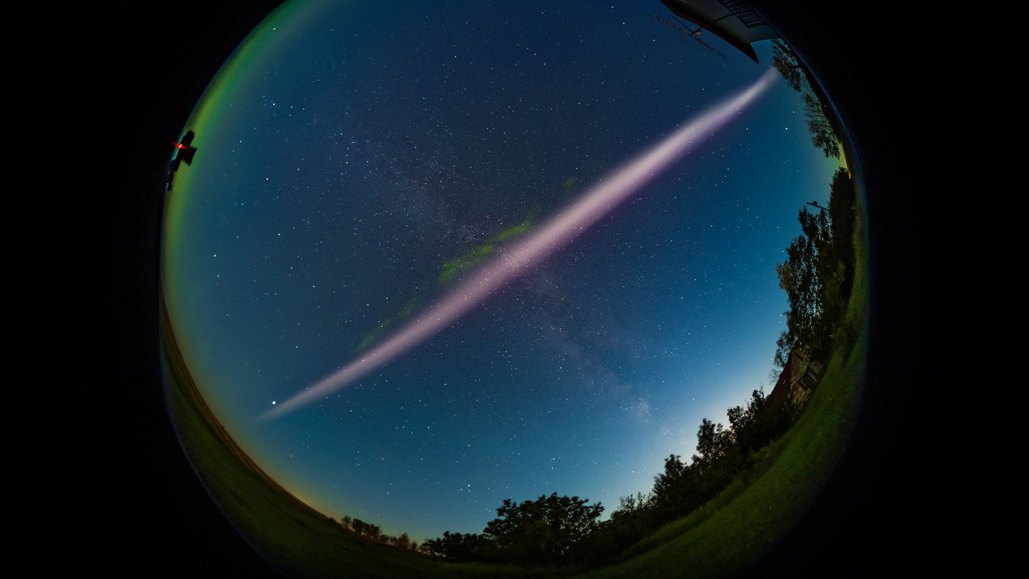Scientists baffled by the intricate physics of STEVE and similar aurora-like phenomena

In the rural areas of Alberta, Canada, Alan Dyer used his backyard's pure darkness to capture beautiful images of a rare sky glow named STEVE. Normally, he allows his camera to gather light over several seconds, which highlights STEVE's unique color but glosses over its smaller details. However, an opportunity in August 2022 led Dyer to utilize a different method.
He chose to zoom into the sky glow with his camera and film STEVE in high detail, taking 24 snapshots every second. Instead of the familiar sleek drift of purple, the footage revealed STEVE as an erratic, flickering flood of purplish-white tones.
Though Dyer described the sight as less aesthetic, he forwarded the video to Toshi Nishimura, a space physicist at Boston University, in case it held scientific value.
Nishimura was thrilled to receive such a clear view of STEVE but found that the tiny details did not match scientists' preliminary ideas about the atmospheric chemistry underlying the airglow. This diverted our understanding and puzzled them.
Such confusion is typical when researching STEVE, which is an acronym for Strong Thermal Emission Velocity Enhancement. Ever since citizen scientists began presenting their images of STEVE years ago, it raised more queries than it solved.
Bea Gallardo-Lacourt, a space physicist at NASA’s Goddard Space Flight Center, explained that each new discovery about STEVE equates to an exponential number of new physics questions.
During an American Geophysical Union meeting in San Francisco in December, Nishimura’s team showcased this high-definition view of STEVE. Other scientists presented perplexing observations about another non-aurora sky glow morphing into STEVE. Some clarity came in the form of a computer model that might explain the green "picket fence" stripes sometimes emitting from underneath STEVE.
Claire Gasque, a space physicist at the University of California, Berkeley, stated that understanding STEVE and the picket fence phenomenon could contribute to the broader field of space physics. Plus, as conditions in Earth's atmosphere where STEVE appears can affect satellite transmissions, further knowledge about this air glow might extend to practical applications.
Canadian aurora chasers first introduced STEVE to the science world in 2016. They quickly noted that STEVE was different from an aurora -- the latter appears near the Earth's poles, while the former presents itself closer to the equator. Alan Dyer, for instance, noted that while auroras typically occur to the north of his location in Alberta, STEVE could appear directly overhead.
Later reports linked STEVE to a flow of charged particles moving through the atmosphere at high speeds, creating the purple glow around 200 kilometers above the ground. However, the exact molecules responsible for STEVE's distinctive hue remain a mystery, especially given the new insights provided by Dyer's footage.
The intimate details Dyer's footage captured of STEVE showed a clumpy, dotted purple stream, rushing westward at about 9 kilometers per second. Transient variations in brightness appeared and disappeared within seconds, further complicating existing hypotheses.
Nishimura suggested that launching a rocket carrying sensors through STEVE could help identify the molecules. However, the difficulty lies in predicting when and where STEVE would occur.
STEVE, a unique light phenomenon, often appears after the height of substorms, which are disturbances in the magnetosphere resulting in incredible auroras. However, not every substorm is accompanied by a STEVE event, and according to research presented by Gallardo-Lacourt and her team at AGU, not all STEVE phenomena require a substorm to manifest.
Nishimura suggests that gaining a deeper understanding of the connection between STEVE and a non-auroral airglow known as a stable auroral red (SAR) arc could help researchers better predict STEVE events. Photos from citizen scientists indicate that a SAR arc might transform into STEVE.
In March 2015, citizen scientist Ian Griffin captured an extraordinary auroral display near Dunedin, New Zealand. During this event, Griffin noticed a broad, red sky glow that transitioned into the mauve strand identified as STEVE. This footage provided researchers their initial observation of a STEVE developing from a SAR arc. This finding was reported by space physicist Carlos Martinis from Boston University and his team in June 2022 in Geophysical Research Letters.
SAR arcs, similar to STEVE, have been studied by scientists for many years. These airglows, seen closer to the equator than the northern and southern lights, stretch from east to west across the sky. In contrast to STEVE's approximate hour-long show, SAR arcs can illuminate the sky from hours to days, although generally faint to the naked eye.
When disturbances in Earth's magnetosphere result in charged particle collisions thousands of kilometers away in space, SAR arcs form. This collision creates heat that seeps into the ionosphere - the layer of the atmosphere where STEVE resides. The resulting heat propels electrons to stimulate oxygen atoms to release red light that is approximately one-tenth as bright as auroras. The SAR arc observed by Griffin was luminous enough to rival red southern lights.
The captivating footage captured by Griffin led Megan Gillies from the University of Calgary in Canada and her team to look for other instances of STEVE developing from SAR arcs. They reported a case discovered by the Transition Region Explorer, or TREx, Spectrograph at Lucky Lake, Saskatchewan in April 2022, in Geophysical Research Letters in March. A bright purple streak characteristic of STEVE emerged from a SAR arc's red glow, lasted for around thirty minutes before shifting back to red.
What causes not all SAR arcs to transform into STEVE is unclear. Gillies suggests that the plasma stream that fuels STEVE plays a role, as SAR arcs have also been associated with westward flowing plasma in the atmosphere. However, these plasma flows are slower than those that power STEVE. Data from a satellite showed a broad plasma stream in the atmosphere narrowing and accelerating into a filament typical of STEVE as the SAR arc witnessed in 2015 evolved into STEVE. This transition's trigger remains unknown, and what complicates it even more is the observation of STEVE and SAR arcs co-existing but seemingly functioning independently, as witnessed by citizen scientists.
Gillies emphasizes the value of modeling in attempting to comprehend these phenomena. Physicists can utilize computer simulations to verify if their theoretical physics can produce light patterns resembling STEVE. These simulations also assist in solving another STEVE-related mystery— the origin of the picket fence.
Initially, scientists speculated that the green stripes that occasionally accompany STEVE, known as the picket fence, were ordinary auroras. However, the specific wavelengths radiating from the picket fence indicated that it might not be an aurora (SN: 11/12/20).
Normal auroras are illuminated by charged particle showers from the magnetosphere. The collisions of these particles with the atmosphere produce a range of colours, including green from oxygen and red and blue from nitrogen. Not observing the blue is one evidence that the picket fence's green spires differ from classic auroras, according to Gasque.
An alternative explanation for the picket fence might be electric fields embedded within Earth’s atmosphere that run parallel to the planet’s magnetic field, Gasque says. Those fields could energize local electrons to excite oxygen into glowing green and coax nitrogen to give off a bit of red but not blue. Gasque and colleagues ran a computer model of Earth’s atmosphere with electrons energized by electric fields. The team compared the light produced inside their simulated atmosphere with light from a picket fence seen by the TREx Spectrograph at Lucky Lake in April 2018.
The model did indeed reproduce the ratio of red to green light seen in the real-life picket fence without a tinge of blue — bolstering the idea that atmospheric electric fields could construct the picket fence, the researchers reported November 16 in Geophysical Research Letters and at the AGU meeting. But scientists need to confirm that such electric fields actually exist at the altitudes where picket fences appear.
“The plan now is to try and fly a rocket through one of these structures,” says Gallardo-Lacourt. Gasque and her colleagues have just proposed such a mission to NASA. The rocket wouldn’t fly through the picket fence — which, like STEVE, is too hard to predict. Instead, it would target phenomena with similar coloring that are far more common: enhanced auroras.
“With enhanced aurorae, you have kind of these sharp, bright layers within the aurora,” Gasque says. The sharpness of those variations in auroral light and their picket fence–like color scheme hints that they might be powered by electric fields as well. If a future rocket mission detects electric fields threaded through enhanced auroras, that would help confirm that similar fields build the picket fence.
NASA’s Geospace Dynamics Constellation mission will also launch a fleet of spacecraft as early as 2027 to probe Earth’s magnetosphere and ionosphere — which might yield more data that help explain aspects of STEVE, Gallardo-Lacourt notes. In the meantime, STEVE’s dedicated paparazzi of citizen scientists will continue snapping photos of the phenomenon from the ground.
“We’re out specifically looking for STEVE and knowing that there’s scientific interest in it,” Dyer says. “Prior to the era of STEVE … you might have thought, well, there’s nothing amateurs can contribute now to aurora research, it’s all done with rockets and satellites and the like. But nope! There’s a lot we can contribute” — even if those contributions are often new puzzles for scientists to solve.




